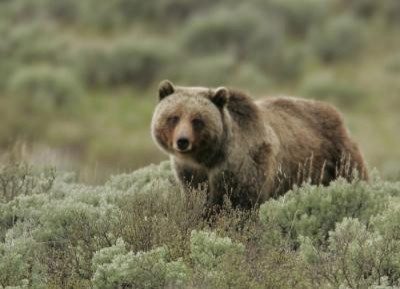Wolves Help Bears In Yellowstone By Controlling Berry-Eating Elks: Study

The wolves of Yellowstone National Park may be indirectly helping one of the forest's other big predators: the grizzly bear.
In a new study appearing in the Journal of Animal Ecology, Oregon State University and Washington State University scientists say that Yellowstone grizzlies are eating more and more berries since the introduction of wolves. Before the wolf was reintroduced into the park in the 1990s, elk herds browsed much more freely among berry-producing shrubs, aspen and willow trees.
"Wild fruit is typically an important part of grizzly bear diet, especially in late summer when they are trying to gain weight as rapidly as possible before winter hibernation," lead author and OSU researcher William Ripple said in a statement. "Berries are one part of a diverse food source that aids bear survival and reproduction, and at certain times of the year can be more than half their diet in many places in North America."
After the grey wolf virtually disappeared from the Yellowstone area in the 1920s, populations of their prey animals -- particularly elk and bison -- exploded, upsetting the existing ecological balance. In 1995, federal officials reintroduced wolves to Yellowstone and Idaho, using fewer than 100 animals taken from packs in Alberta, Canada. Once released, their numbers have steadily risen. The U.S. Fish and Wildlife Service estimates that by the end of 2012, there were about 1,674 adult wolves in 321 packs in the Northern Rocky Mountains.
Now, with the wolf back in action, the elk population is slowly being reduced, and a wide variety of berries – including the chokecherry, huckleberry, and serviceberry – are more readily available. In their study, Ripple and his colleagues looked at the amount of fruit found in bear droppings in the park over a 19-year period. They found that the proportion of fruit in bear scat rose significantly after the wolf was reintroduced to Yellowstone.
In his previous work, Ripple and colleagues have shown that the return of the wolf to Yellowstone has benefited certain trees favored by hungry elks. Willows, aspen and cottonwoods have all resurged in recent years.
"We’re in the early stages of this ecosystem recovery. This is what we call passive restoration," Ripple told the LA Times. "We put the wolf back in and then we let nature take its course.”
More berries for bears may mean a boon for ranchers as well. Ripple and his colleagues note in their paper that just before the grizzly bear went extinct in the American Southwest in the 1900s, the bears tended to go after livestock. One explanation for the grizzly bear’s increased taste for beef and mutton is that livestock grazing eradicated the bears’ plant-based food sources, the scientists say. So, if you keep a bear supplied with berries, you may have fewer worries about your cows.
© Copyright IBTimes 2024. All rights reserved.





















